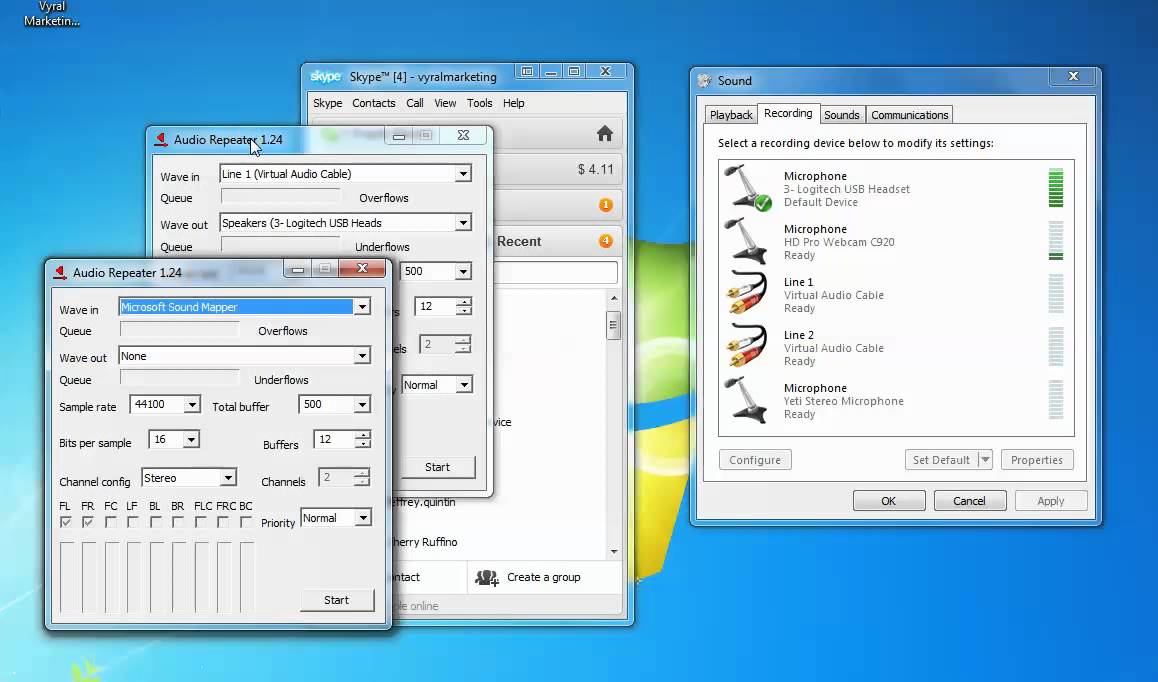

- Virtual audio cable alternative manual#
- Virtual audio cable alternative full#
- Virtual audio cable alternative free#
- Virtual audio cable alternative windows#

I'm curious about any advice and or experience running virtual cables. This is new for me, though I have plenty of experience with real-world patching on sound systems, as well as being very comfortable technically (engineer on the day job).
Virtual audio cable alternative full#
You have created a full audio path containing Virtual Cable 1.I'm needing to run some virtual audio cables for some internal patching in my computer. It means that audio data are transferred from a playing application to Virtual Cable 1 and then Audio Repeater transfers them further to a hardware audio device. Now you must hear a sound played by an application started first and the Control Panel application must show a new recording/capture stream. If a sound is really played to the Virtual Cable 1, run Audio Repeater (MME variant) application and choose Virtual Cable 1 as a recording (Wave In) device and your hardware audio device as a playback (Wave Out) device.Īctivate audio transfer clicking Start button in Audio Repeater. If you hear a played sound, it means the application directs it to your hardware audio device, not to Virtual Cable 1. You should hear nothing but VAC Control Panel must show 1 or 2 new playback streams for Virtual Cable 1 and cable signal level indicator should be shown. Start playback and make sure that the application really plays to Virtual Cable 1. Run any audio producing application (a player, a tone generator, an audio editor) that allows you to specify a playback/render device directly and choose Virtual Cable 1. To use a cable simplest possible way, first run VAC Control Panel application and make sure that there are 1-3 cables and they are configured with typical parameters:ĭon’t close VAC Control Panel, it will help you later. There are two available to select from and I used the MME one.
Virtual audio cable alternative manual#
To get a feel of how it works and to satisfy my curiosity, following this section of the manual gave great proof of concept, especially when you run the Audio Repeater. VAC has its own control panel and I’ve left it purely as the default settings. To get the audio out of SDRConsole and into Fldigi it’s as simple as selecting the Audio setting within SDConsoleįldigi is using the virtual audio as an input source and everything, just works. Virtual Audio Cable on the other hand worked instantly. Unfortunately as hard as I tried I just couldn’t get VB-Audio Virtual Cable to work, which is a shame as it looks good.
Virtual audio cable alternative free#
The most popular is Virtual Audio Cable (current version is 4.14)Ī free alternative is VB-Audio Virtual Cable There are several virtual audio packages in existence which attempt, with varying degrees of success, to achieve this.
Virtual audio cable alternative windows#
The only difference is it isn’t physical.Īs the screen shots show, once installed on a system, Windows displays the Virtual Cable as any other sound device plugged into the machine. Think of a virtual audio cable as any other lead that you plug things into or equally plug into things. Sounds complicated? Trust me it isn’t when you’ve got the very simple setup and config screens in front of you. As many applications as are necessary can tap into this bus and multiple virtual cables can be created.

Equally to use the output in Fldigi to decode CW, PSK31 etc there needs to be a mechanism to pipe the audio between applications.Ī virtual audio program pipes the output from SDRConsole, normally destined for your speakers, onto an audio bus which is then available to any application requiring an audio input. Unless the radio is used directly at the desk, with a set of speakers plugged into it, it’s not possible to hear any audio output.


 0 kommentar(er)
0 kommentar(er)
